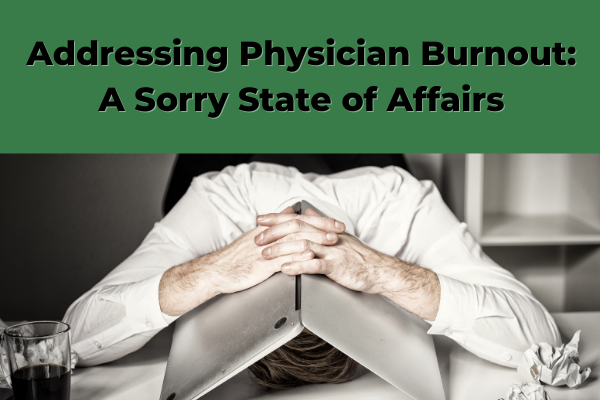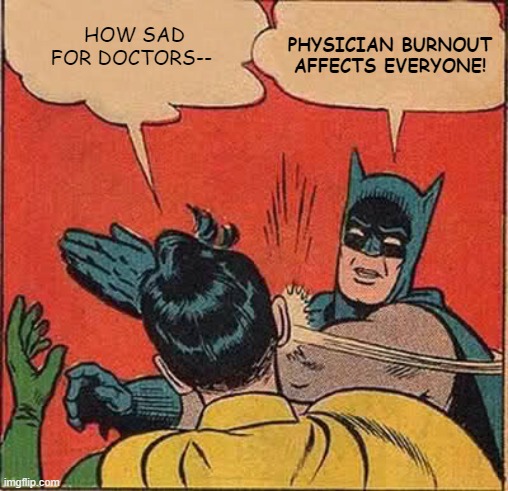In last week’s post, I explored how charting is the number one of physician burnout as identified on the Medscape National Physician Burnout & Suicide Report 2021.
This week’s post looks at the response to physician burnout on a national level.
Let’s get to it!

"Don't Just Do Something, Stand There"
This quote from the late Jack Bogle of Vanguard fame is about investing, but unfortunately sums up the efforts to combat physician burnout on the national level.
In short: quite disappointing.
Legislative efforts to improve our lot often imperil the finances or strangleholds that our unholy bedfellows in healthcare (e.g., health insurance companies, pharmacy benefit managers, drug manufacturers, etc.) have on the system—we cannot compete with the monies and lobbying efforts these bedfellows levy on politicians, and so more often than not we lose.
For example, vested interests ensured passage of bills mandating use of electronic health records (EHRs) without interoperability standards in place, severely limiting the ability of physicians to care for patients who seek care across multiple healthcare entities. Physicians were forced to purchase at great cost EHRs that often don’t serve their or their patients’ needs.
According to the Medscape survey referenced these past few posts, increased computerization/use of EHRs ranks in the middle of contributors of burnout without about 30% of physicians reporting it as such.
Now don’t get me wrong—I’m not anti-EHR. I handwrote notes throughout medical school and it was painful. I’m just anti-current-iteration-of-woefully-inadequate-EHRs.
Heads in the Sand
Physicians bemoaning the healthcare system and/or trying to seduce mates.
Physicians generally do not self-advocate, struggle to coalesce around issues, and have no effective mechanism for lobbying en masse.
Some bury themselves in their work (often a form of buffering, as discussed here) and don’t allow for time for self-care much less advocacy work.
Some focus their efforts on patient advocacy (which is needed!) but eschew physician advocacy. However, by sub-serving our needs every time, we lose the chance to make medicine more sustainable. I’d contend that physician advocacy is also patient advocacy.
Others yet believe the issues with healthcare in our country are insurmountable, and thus resign themselves to defeatist or fatalistic attitudes.
Finally, physicians are disorganized. Yes, our desks may be littered with papers, but I mean as a professional group. We are extremely divided, and that hampers our ability to get things done at the national level.
Can We Make the AMA Leave AMA?
There is no truly dominant organization to which physicians subscribe. Back in the 1950s, around 75% of all practicing physicians were members of the American Medical Association (AMA). Today, that number is around 15-20%, if that, for good reason.
In fact, many blame the AMA for some of the quandaries physicians face today.
For example, the AMA controls a monopoly on the billing (CPT) codes that we have to use for every patient encounter. In fact, revenue from use of these codes makes up the majority of their funding.
I sense a conflict of interest!
The AMA has been very pro-EHR rollout over the years because the EHR is essentially their cash register. They have an inherent conflict of interest for EHRs to remain primarily billing tools with thin veneers of user interface to help physicians actually provide patient care.
The AMA also controls physician reimbursement via a committee called the RUC (Relative Value Scale Update Committee), on which CMS (Centers for Medicare and Medicaid Services) relies to set payment amounts for physicians’ services.
This is a static pool of money and every year the various specialties are pitted against one another vying for a larger share of the pie. This generates a lot of in-fighting and divides us further. Divided we fail.
This Is Bigger Than Us
Burnout is not only a professional crisis, but also a public health one.
The AAMC (Association of American Medical Colleges) projects that by 2033, the US could have a shortage of up to almost 140,000 physicians!
By my rough back of the napkin calculations, that is about 10% of the physician workforce!
The AAMC report considers neither early retirement from medicine nor cutting back work hours due to burnout in those estimates, so I’d venture to guess that the forecasts are underestimating the true shortage.
Holy Lack of Care, Batman!
A certain percentage of burned-out physicians will leave medicine earlier or scale back their work hours.
The implications of this are huge. The US already struggles with access to care especially in lower income neighborhoods and rural areas.
Now imagine being short by ~10%.
More patients will suffer, especially the elderly, those with mental illness, non-English speakers, and the impoverished. Disparities and inequities will worsen.
Humor Me
What if we as physicians were able to practice our craft in a system in which the main driver of burnout—charting—was minimal or somehow automated?
What if we could double our 27% of time spent on patient care to 54%?
I suspect we would increase physician career satisfaction and be able to mitigate at least some of the predicted physician shortage.
We could keep happier doctors working full careers and serving more patients (i.e., seeing more daily due to less time spent on charting) throughout those careers.
Did I just link charting with healthcare access!?
I know, I know, you’re like:
In the Interest of Being Balanced...
While I shake my head at national efforts overall, there have been some positive recent trends.
Specifically, CMS via their Patients Over Paperwork initiative pushed through improvements in documentation requirements in two key areas.
The first is counting prior notes as having been reviewed and not requiring doctors to regurgitate an entire history or items documented elsewhere in that encounter (like the nursing note), which contributes to “note bloat.”
Second, as of January 1st, 2021, billing for encounters is entirely based off of medical decision making or time spent, so physicians don’t need to worry about hitting x number of elements for history and exam—they only need to document truly relevant items in these sections.
And I would be remiss not to throw the AMA a bone. There are physicians within the AMA that strive to improve our lot.
Dr. Christine Sinsky is one of them. She’s the VP of Professional Satisfaction for the AMA and is a vocal physician advocate. She oversees studies related to burnout and promotes programming such as the AMA’s STEPS Forward to help address burnout. We need more leaders like her. (I’m sure after publishing this ringing endorsement, she’ll be embroiled in some random scandal…).
Turn the Tables
These gains are steps in the right direction. However, they are drops in a bucket. Much more action is needed and soon.
Physicians will have to come together to tackle the systemic issues driving us out of medicine.
Instead of passively accepting, quietly complaining, or disengaging, we need to go on the offensive to effect the change needed to reclaim medicine.
Physicians need to be back at the table shaping our healthcare system to advance and advocate for the needs of not only our patients, but also ourselves.
I hope the post demonstrated the serious lack of both an organized response from physicians as well as representation on the national level.
I’d love to hear your thoughts on this issue. Let me know in the comments section below.
If you haven’t subscribed to my email list, then do so below so you don’t miss my new posts or my weekly updates (only for subscribers).
I’d also be most appreciative if you shared this post with anyone whom you think would benefit from the content or message of the blog.

